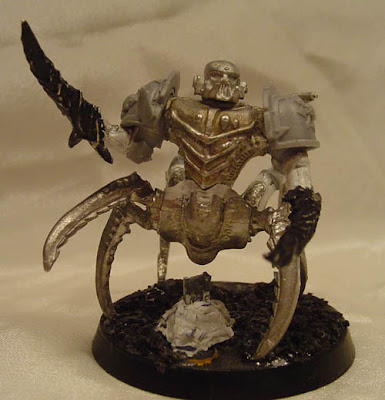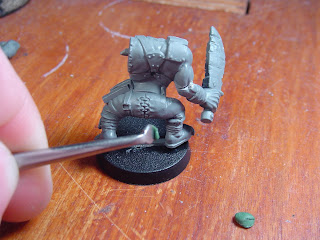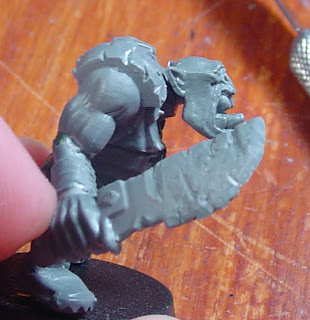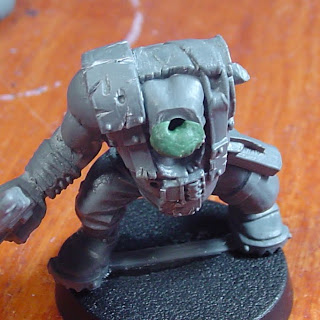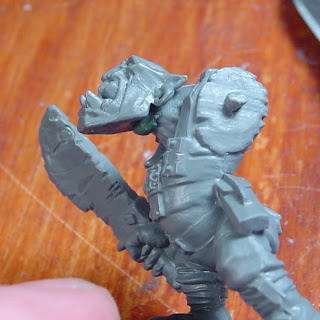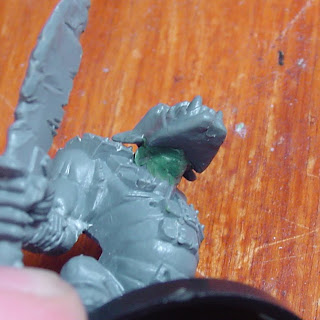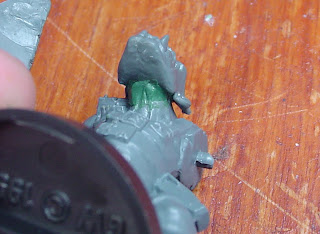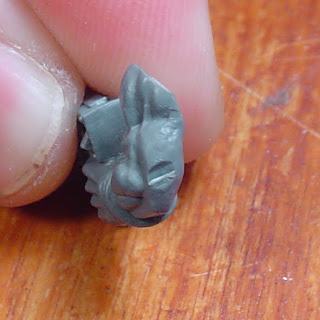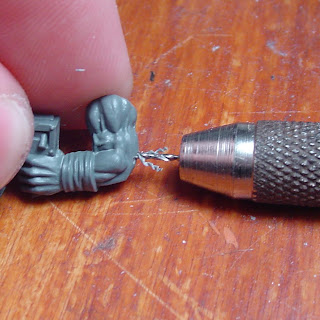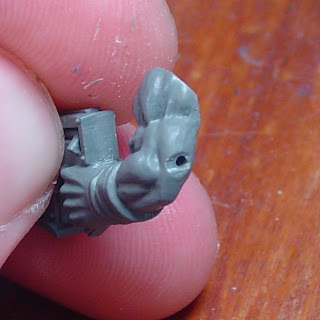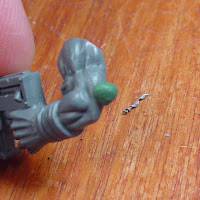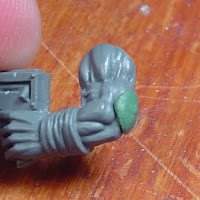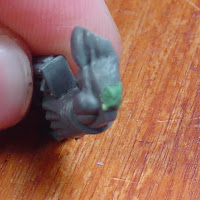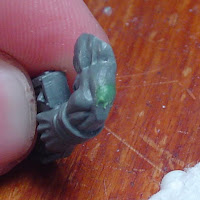Neither my first nor third battles were that tactically interesting. The details are a bit hazy, but they were basically bum-rushing, late game objective grabs and generally un-challenging and boring.
But the SECOND game... oh, that was a good one. Makes me want to travel out to El Paso sometime to return the favor...
I drew Zeus (short for Jesus) and his very nasty Khorne Daemons army. Ironically, right before the pairings a friend of mine was telling me about the list and just how brutal it was. (Ian and his Sisters didn't face Zeus, but was on a table next to him the first game.) I made a crack about how it would be just my luck and that I'd pull that army for the second battle...
As a note, this is just a reconstruction from memory. Some specifics of positioning or wounds caused may not be perfectly accurate... but should be correct enough to show what happened. If something looks to have moved too far, this is purely a fault of the reconstruction.
To save you back-tracking on what's what:
My List: Eldrad w 10-man Council in Yellow Serpent, Farseer w 8-man Council in Yellow Serpent, 2x6 Dragons in Red Serpents, 1x10 Banshees in Green Serpent, 1x10 Fire Storm Guardians w Destructor Warlock in Black Serpent, 3x Guardian Jetbikes, 1x DAVU Falcon w Scatter Laser turret, 3x Scatter Laser War Walkers.
His List: 2x Blood Thirsters, 3x7 Blood Crushers, 4x13 Blood Letters, 1x Soul Grinder, 1x Khorne Daemon Prince.
Another interesting thing about this tourney: the terrain fairy was on strike. The store had stacks of terrain on the walls, but almost every table had crap for cover. This was actually one of the "better" boards in that it had 5 pieces, though most were near useless with how they were positioned. The board looked generally like this:

The two round sections were craters and the ruins were all Cities of Death single-story with very open LOS through them. If you look to the right of the board: his Wave 1 was the top selection of Thirsters, Crushers and Soul Grinder. His Wave 2 was the Letters and Prince.
TURN 1: Zeus won the roll for turn choice and decided to go first. I think he was worried about getting guys on the board as fast as possible. I put everything into Dawn of War Reserves, except the Jetbikes which went into normal Reserves. He rolled for his Wave... and got a 2! Then I got a second lucky break: his Daemon Prince deviated 10" back to land 1/2" off the board and kill himself with a Deep Strike Mishap! Neither of these two items was THAT critical to the game, but certainly helped alleviate the pressure early on.

He went heavy left, obviously hoping to draw me over there and away from the mass of objectives.
For my turn, I obliged moved on at the left. I knew my mobility could get me to the objectives when needed. I also knew I'd need to concentrate my fire and eliminate entire squads as fast as possible to avoid getting bogged down in close combat. I had some nice Night Fight rolls and blasted a few Letters that had strayed into my sights. Knowing he had a bunch more Daemons to drop in, I castled up my forces to keep him from Deep Striking into the middle of them.

In retrospect, this probably wouldn't have mattered since I had the speed to get away... but I wanted him thinking I was afraid of his assaults and going more shooty.
TURN 2: At the start of this turn the first objective went live... right between our forces. Ouch... especially when a unit of Crushers and a Thirster dropped on top of it. This pretty much decided where the main engagement would be. The Soul Grinder also dropped in and popped a War Walker (Immobilized) while the Letters on the left all backed off to avoid my guns.

Soul Grinder, meet Fire Dragons. Two Weapon Destroyed and an Immobilized meant it wasn't dead, but wasn't a threat either. Since this opponent wasn't shooty, both Councils Fortuned themselves rather than their rides; moving up to face the right flank threat. A nice round of Falcon and Serpent shooting also dropped a bunch of Letters. Then a bunch of fire also went into the Crushers and Thirster, but Night Fight and saves kept the wounds to a minimum and spread about the unit.
 TURN 3:
TURN 3: Shock, horror and surprise... a Khorne list opted to charge! All he could get was Crushers into the Council Serpents. Sadly, his attacks worked as expected and managed to drop both Serpents. However, they were both Penetrating 5's... and Destroyed results don't hurt passengers.

Neither Council was Pinned, so the scrum REALLY started. Eldar charged Khorne! Hah. My opponent confessed he thought I was insane... but then he learned what Seer Councils can do. He was nicely bunched up for Destructors. Add on a nice charge and the were Crushers hurting for little damage to the Councils. The Dragons finished off the Soul Grinder and Night Fight suppressed most everything else that was interesting.
 TURN 4:
TURN 4: Here the second objective went live... right in the middle of his forces. Bah! It was time for his retribution too, with the Thirster and a squad of Letters jumping into the scrum. Fortuned Saves kept the Thirster from doing anything and Doom kept the wound total about even.

Now I had to take some risks this turn... that big squad of Crushers up top got Doomed by Eldrad, shot up, and then charged by the Banshees. They lost 1/2 their squad in this, but the Crushers didn't get away unscathed either. I also finished off that first Letter squad and moved my Dragon Serpent so the third Crusher squad couldn't charge into the scrum. The Guardian Serpent made a jump to mid-table in hopes of distracting him a bit and positioning them in case we ran out of time on 5 or something. Then we went into CC and the Scrum saw off the last Crusher there. This meant Eldrad and all those witchblade toting Warlocks could start throwing their attacks into the "softer" Letters...
 TURN 5:
TURN 5: Thirster 2 jumped my lines to eat the Fire Dragons while the letters took down the Dragon Serpent. The Crushers up there also finished off the Banshees... a painful sacrifice, but it kept them occupied for the turn needed. The Crushers on the right took the Guardian bait and double charged with the Letters to block th Serpent's rear hatch. But all those attacks meant a Pen 6 was almost inevitable. It Exploded, I lost some Guardians, and the squad was still free to play on my turn. But best of all, the Letters get beaten down by witchblades and I win combat by 10 wounds. Even the Thirster loses his last wound against that many rolls...

With the big Scrum ending at a perfect time, I see a golden opportunity to wreak more havoc. Eldrad and Co head north to wipe the last of the Curshers there and then spread out so the Thirster can't jump their line and contest the objective. The Dragon Serpent and Stormies finish the arc to isolate the 2nd objective. The Stormies unleash their fire on the Letters... and manage to kill all but one! Massed Flamer templates for the win, but it did gimp my plans to charge them. :-p Meanwhile the Farseer and Co hit the right Crusher unit to draw them away from the objectives as well as pin them in place. The Falcon got out of the Thirster's charge range... and then failed Night Fight to shoot it.

TURN 6: Then the last objective comes in. I have a 3/4 chance that it'd be somewhere easy for me to grab. But no, Fate has to be a fickle bitch and it pops right in the middle of his unit of Letters on the left. *sigh* Fortunately, the FarSeer and Co manage to hang on against the Crushers. The Council successfully frustrated the Thirster from jumping them, so it decides to drop a tank instead. It was Immobilized and Weapon Destroyed, but not dead. I'm not reseting the entire Vassal game just to fix this one item. :p

And the killing blow is applied. Tank Shock denies him the objective on the left. (I actually had my tank such that I probably had it in my favor, but it was questionable.) Then the Dragons pop that last Letter while the Stormies advance to grab the objective. I had two objectives solid, so even though the Crushers popped the Farseer it wouldn't have mattered if they Consolidated to contest. (They rolled a 1 anyways...)

Objectives: 2 Eldar, 1 Contested
Kill Points: 9 Eldar, 8 Daemons
Final Result: Massacre for the Eldar, with a bonus point for having more Scoring units in his deployment zone (2) than he had in mine (0).
Close, fun, nail-biting, and tactically challenging. This was a top-notch game, army and opponent.
Cheers and hope you've enjoyed the read. (And Alex, I haven't forgotten your question on Outflanking Genestealers...)
 Hey there folks.
Hey there folks.

























